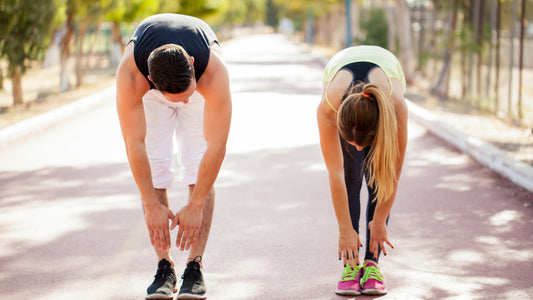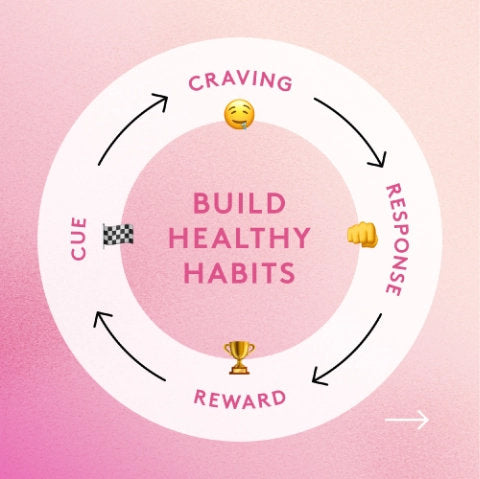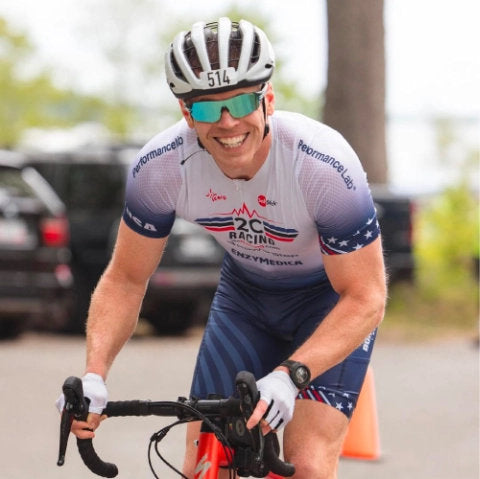I’ve no shame in admitting I have a suggestible personality.
I am easily influenced. Easily encouraged. And I’m partial to an impulsive purchase.
TikTok is a dangerous place for me.
But Dr Mandell on TikTok says that walking backwards can change my life.
And as I watch Dr Mandell walk confidently backwards through his local park, I can’t help but notice how his gait is different. How his posture does change. He definitely places his feet differently to how he would if he were walking forward.
I think there might be something in this.
Now I don’t know if he’s a real doctor. I’ve done zero background checks. But he wears scrubs and has 3.2 million followers.
And that’s good enough for me.
Because he’s lit the touchpaper. And if he’s right, then walking backwards for just 15 minutes per day can improve my balance, memory, cardiovascular fitness, muscle and joint strength, and burn more calories.
But before I reverse myself round the local park, I need to know how true this is. I need to find some actual science to back it up. What are the proven benefits of walking backwards?
The Science of Walking Backwards

Walking makes you live longer.
This is according to a 2020 study that tracked the daily step count of nearly 5000 40+ year-olds.
The data was collected over a ten-year period. The findings indicated that those participants who walked a minimum of 8,000 steps per day, had a 51% lower death rate than those who walked 4,000 or fewer. (1)
So why do we need to walk backwards?
Apparently the Chinese have a saying that 100 steps backwards are worth 1000 steps forward.
It turns out that far from being the 'latest TikTok trend,' walking backwards for health benefits has been going on for centuries. And like a lot of other good things—tea, silk, acupuncture, and wheelbarrows—walking backwards originated in Ancient China.
So come on then, what’s so good about it?
Physical Health Benefits of Walking Backwards
Firstly, it stands to reason that walking backwards, also known as retro walking or reverse walking, targets different muscle groups than walking forward.
But is it better than walking forwards?
When we move forward, we mainly use our anterior chain muscles like the quads and tibialis anterior. Walking backwards shifts the focus to the glutes, hamstrings, and calves.
Not only does this give our butts a great workout, but it also has more meaningful benefits for other parts of our bodies. It can reduce pressure on the knees, strengthen muscles in our backs, burn more calories and improve our memory.
In my quest for evidence to support this, I found lots.
It turns out physical therapists have been recommending walking backwards as an exercise for easing back pain, knee problems and arthritis for years.
Here’s what I found…
Back Pain

The lumbar region around our lower spine is involved in a wide range of movements, from bending and twisting, to lifting and standing. This group of muscles are key for stability, support, posture, and core strength. Anyone who’s had the slightest of back twinges knows how crucial it is to look after these muscles.
A 2018 study showed that walking backwards is particularly good for strengthening the lumbar region muscles. People with and without back pain who tried walking backwards activated their back muscles much more than when they walked forward. (2)
The takeaway was that not only does walking backward help in strengthening your back, but it could also be useful in managing and even preventing back pain.
For those that have niggling back pain already. A study from the University of Nevada, Las Vegas found that athletes who walked backwards for three weeks saw big improvements in lower back pain and how well they could move. (3)
Participants reported they could move more freely and felt less shock to their lower backs, suggesting that three weeks of activity could really help ease back issues and boost overall mobility.
So whilst we’re all pretty familiar with the usual, ‘bend at the knees when lifting’ advice, there’s evidence to support that walking backwards could be useful as both a preventative measure to strengthen muscles in the back, but also as a rehabilitation tool for existing back pain.
Knee Pain

If you watch someone walking backwards, you’ll notice that the forefoot is the first thing that makes contact with the ground.
This softens the landing and makes the movement more controlled than if you were landing heel first. In this instance, the ankle takes most of the weight. (4) This type of landing reduces the impact force that travels up through the knee joint, which can ease stress on the joint.
For those experiencing knee pain down to osteoarthritis, incorporating backward walking into your routine could be a game-changer for you too.
A comprehensive study conducted over six weeks tested the effects of backward versus forward walking on individuals with knee osteoarthritis. (5) The results were clear: those who participated in walking backward reported significantly more relief from pain, and reduced functional disability compared to those who walked forward or only received routine physical therapy.
Athletic Performance

You often see athletes running or walking backwards as part of their warm-up routines.
This type of exercise does more than just prepare the muscles; it's particularly beneficial for sports that require quick shifts in direction and pace. In activities where agility is crucial, like court sports, backward movement may give us the edge.
A study conducted with netball players over six weeks demonstrated that those who incorporated backward walking into their training showed significant improvements in agility tests compared to their forward-walking counterparts. They became quicker at changing directions and navigating the court. (6)
Another analysis published in the Strength and Conditioning Journal highlighted that this type of training method not only helps in reducing injury risk, but can also boost anaerobic fitness, enhance vertical jump height, and improve sprinting speed and agility. (7)
These particular benefits are thought to be down to the higher energy expenditure and unique biomechanical load involved in backward running. Walking backwards uses almost 40% more energy than walking normally at the same speed (6.0 Mets versus 4.3 Mets). (8) The body has to work harder to move. It needs more muscles, more effort, and therefore more energy.
Which brings us to the burning question:
Does backward walking help with fat loss?
Body Fat

The jury’s still out on this one.
When looking for proof that backward walking reduces body fat, one study that’s frequently mentioned is a 2005 investigation into the effect of backwards locomotion on the body comp of young women. (9)
26 healthy females were split into 2 groups. The training group underwent a six-week backward run/walk training program, while the control group continued with their usual daily activities.
According to the study, at the end of the six weeks, the training group saw a significant reduction in body fat and skinfold measurements, along with improvements in oxygen efficiency. Suggesting that walking or running backwards could be a great way to lose fat.
However, it’s worth noting that these results were compared to a control group that “continued with their usual daily activities”. It does state that they were healthy females. But the stipulation was that they carry on exactly as they had done, in the 4 weeks leading up to the testing window. So whatever exercise routine they kept during that lead-up period, they continued with during the study. Meaning if they didn’t do any exercise, they continued to do nothing.
So, while backward walking looks promising for fat loss, it really depends on what and how much exercise the control group were doing. Which we don’t know. More research is needed to directly compare it with forward walking to see if one is definitely better than the other.
Cognitive Improvement

If you really want to jog your memory, jog backwards.
Studies have shown that taking a few steps back can improve memory and cognitive abilities too.
A study investigating backward stepping and brain activity discovered heightened activity in the prefrontal cortex during backward movements. This area of the brain is crucial for cognitive functions like planning, decision-making, and problem-solving. (10)
Another study into how movement can influence memory, found that backward motion can significantly improve recall abilities.
Participants engaged in different backward motions—walking, watching a backward-moving video, or even just imagining walking backwards. Those who actually moved backward were better at recalling words, pictures, and details of a staged crime compared to those who moved forward or not at all. (11)
Walking backwards may promote neuroplasticity.
Our brains struggle with the concept and coordination of moving backwards. We can’t just do it on autopilot, so this confuses us. That confusion stimulates our brain, and it adapts, creating new connections between neurons.
How to Start Walking Backwards

I’m no expert, but I’ve done a bit of backward walking in my time.
I’ve stood back to survey the odd painting. I’ve been at the business end of a sofa removal. So as I rewind myself over to the treadmill, I figured backwards walking wouldn’t be so hard.
I was wrong.
As I frantically pressed the decrease speed button, it was evident this treadmill couldn’t go slow enough. It was terrifying and everything was wrong.
But I remembered what Dr Mandell told me, “Hold onto the handrails and start slowly”. So I did. And before long I was taking small steps, without the need for grab rails.
The official advice for starting out is, if you’re on your own, start on a treadmill. Walk slowly, hold the handrails and don’t be tempted to look over your shoulder. Roll through the foot from toe to heel. Once you start to gain confidence, you can speed things up a little and even take it outside.
Final Thoughts
It feels odd, and you will get funny looks. But there seems to be a lot of supporting evidence that demonstrates how walking backwards can offer certain health benefits. We’ve seen it can:
- Improve stability and balance.
- Strengthen lower leg muscles.
- Reduce impact on knee joints.
- Strengthen lower back muscles.
- Ease lower back pain.
- Offer relief from heel pain.
- Improve memory.
I haven’t mastered it yet. My current top speed is only 2km/h, which makes me wonder whether I’ll be reaping all of the above benefits.
So to boost my chances, and make sure I'm supporting my body as it adapts to a new and slightly challenging activity, I’ll be complimenting my training with a joint supporting supplement, a healthy diet and plenty of water. This should help protect and strengthen my muscles while I work on picking up the pace.
If you’re looking for something to support against aches and pains, Performance Lab® Flex is packed with ingredients to nourish and hydrate aching joints, support and strengthen soft tissue and protect you against long-term bone-grinding damage.
- Saint-Maurice PF, Troiano RP, Bassett DR Jr, Graubard BI, Carlson SA, Shiroma EJ, Fulton JE, Matthews CE. Association of Daily Step Count and Step Intensity With Mortality Among US Adults. JAMA. 2020 Mar 24;323(12):1151-1160. doi: 10.1001/jama.2020.1382. PMID: 32207799; PMCID: PMC7093766.
- Ansari B, Bhati P, Singla D, Nazish N, Hussain ME. Lumbar Muscle Activation Pattern During Forward and Backward Walking in Participants With and Without Chronic Low Back Pain: An Electromyographic Study. J Chiropr Med. 2018 Dec;17(4):217-225. doi: 10.1016/j.jcm.2018.03.008. Epub 2019 Jan 20. PMID: 30846913; PMCID: PMC6391229.
- Backward Walking: A Possible Active Exercise for Low Back Pain Reduction and Enhanced Function in Athletes JANET DUFEK1, ANTHONY HOUSE2, BRENT MANGUS3, GEOFFREY MELCHER1, JOHN MERCER1 1Department of Kinesiology and Nutrition Sciences, University of Nevada, Las Vegas, NV, USA, 2University of Pittsburg, Human Performance Research Center, Fort Campbell, KY, USA. 3Texas A&M, Commerce, TX, USA
- Minhyeon Lee, Jungyoon Kim, Jongsang Son, Youngho Kim, Kinematic and kinetic analysis during forward and backward walking, Gait & Posture
- Alghadir AH, Anwer S, Sarkar B, Paul AK, Anwar D. Effect of 6-week retro or forward walking program on pain, functional disability, quadriceps muscle strength, and performance in individuals with knee osteoarthritis: a randomized controlled trial (retro-walking trial). BMC Musculoskelet Disord. 2019 Apr 9;20(1):159. doi: 10.1186/s12891-019-2537-9. PMID: 30967128; PMCID: PMC6456984.
- Terblanche, E., & Venter, R.E. (2009). The effect of backward training on the speed, agility and power of netball players. South African Journal for Research in Sport, Physical Education and Recreation, 31(2). https://doi.org/10.4314/sajrs.v31i2.46335
- Uthoff, Aaron MSc, CSCS1; Oliver, Jon PhD1,2; Cronin, John PhD1; Winwood, Paul PhD1,3; Harrison, Craig PhD1. Backward Running: The Why and How to Program for Better Athleticism. Strength and Conditioning Journal 41(5):p 48-56, October 2019. | DOI: 10.1519/SSC.0000000000000459
- AINSWORTH, BARBARA E.1,2; HASKELL, WILLIAM L.3; HERRMANN, STEPHEN D.1,2; MECKES, NATHANAEL1,2; BASSETT, DAVID R. JR.4; TUDOR-LOCKE, CATRINE5; GREER, JENNIFER L.1,2; VEZINA, JESSE1,2; WHITT-GLOVER, MELICIA C.6; LEON, ARTHUR S.7. 2011 Compendium of Physical Activities: A Second Update of Codes and MET Values. Medicine & Science in Sports & Exercise 43(8):p 1575-1581, August 2011. | DOI: 10.1249/MSS.0b013e31821ece12
- Terblanche E, Page C, Kroff J, Venter RE. The effect of backward locomotion training on the body composition and cardiorespiratory fitness of young women. Int J Sports Med. 2005 Apr;26(3):214-9. doi: 10.1055/s-2004-820997. PMID: 15776337.
- Marika Berchicci, Yuri Russo, Valentina Bianco, Federico Quinzi, Lorenzo Rum, Andrea Macaluso, Giorgia Committeri, Giuseppe Vannozzi, Francesco Di Russo, Stepping forward, stepping backward: a movement-related cortical potential study unveils distinctive brain activities.
- Aleksandar Aksentijevic, Kaz R. Brandt, Elias Tsakanikos, Michael J.A. Thorpe, It takes me back: The mnemonic time-travel effect, Cognition, Volume 182, 2019.














